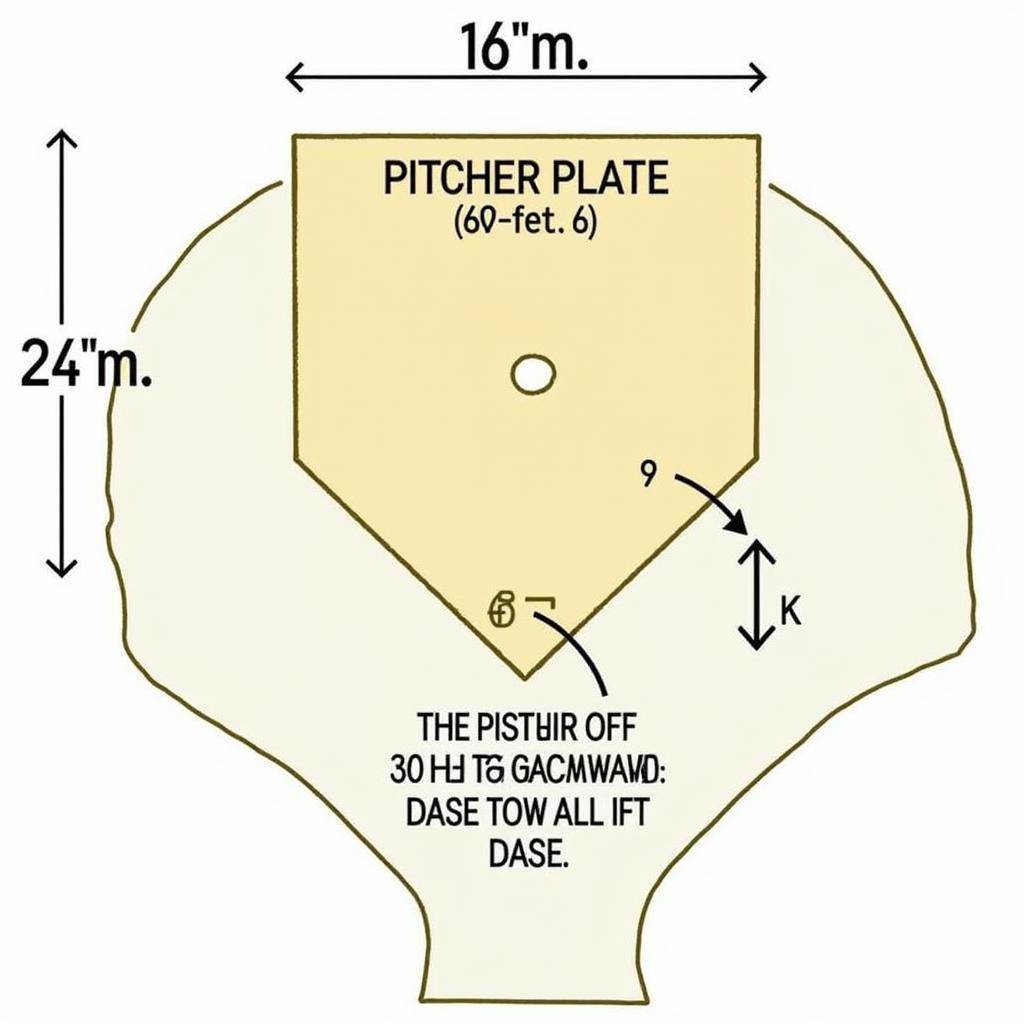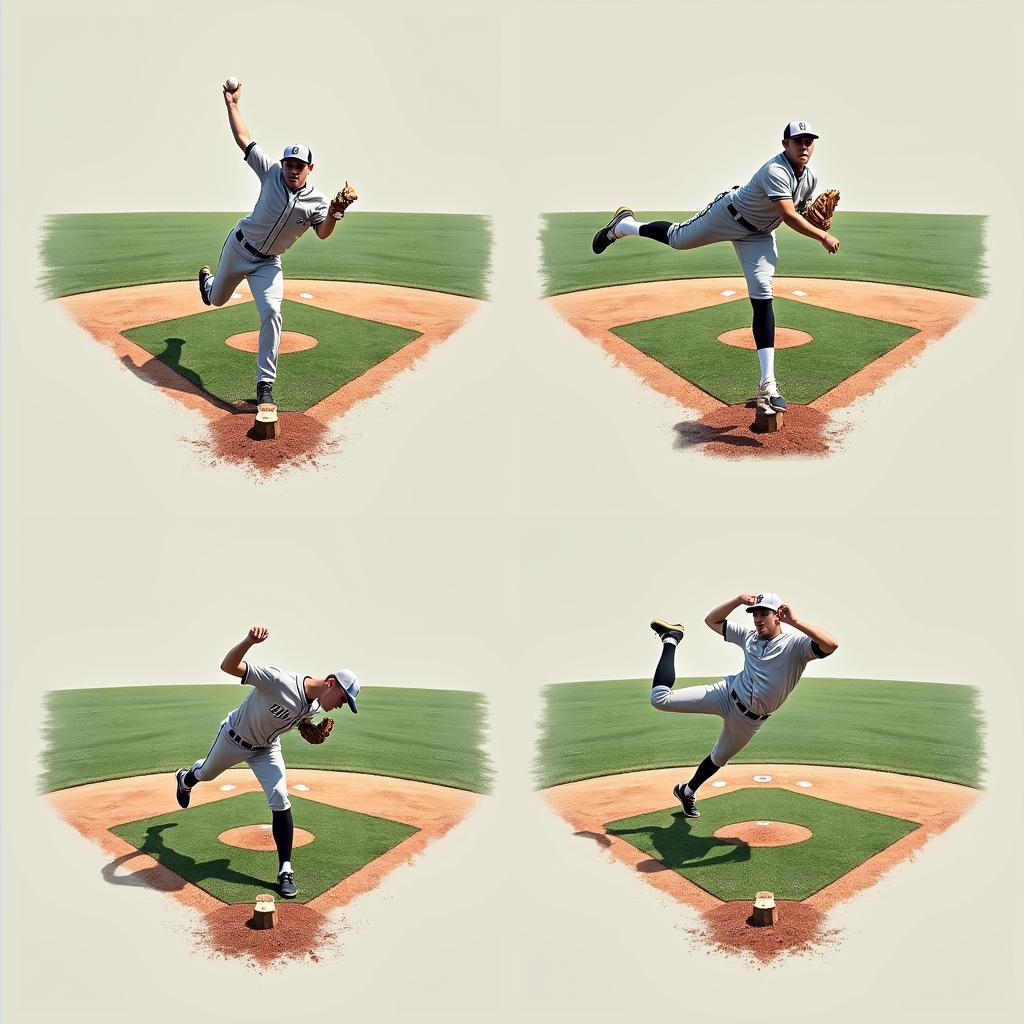Understanding the Pitcher Plate in Baseball
November 2, 2024The Pitcher Plate, a small yet crucial element of a baseball field, plays a significant role in every game. It dictates where the pitcher must stand when delivering the ball, setting the stage for the entire at-bat. This article dives into the specifics of the pitcher plate, exploring its dimensions, regulations, and significance in the sport.
Dimensions and Regulations of the Pitcher Plate
The pitcher plate, also sometimes referred to as the pitcher’s rubber, is a rectangular piece of white rubber, 24 inches long and 6 inches wide. It sits atop the pitcher’s mound, precisely 60 feet 6 inches away from the point of home plate. This specific distance is crucial and is meticulously measured before every game. The front edge of the pitcher plate is the pivotal point for determining the pitching distance. The rules governing the pitcher plate are strict, ensuring fairness and consistency in the game. Any deviation from these regulations can result in penalties.
A key aspect of the pitcher’s interaction with the plate is the rule concerning stepping off. While on the rubber, the pitcher can only step off backward, toward second base. This rule prevents quick pitches or deceptive moves that could unfairly disadvantage the batter. Understanding the nuances of these rules can deepen your appreciation for the strategic elements of the game. Did you know some pitchers use their understanding of the plate’s regulations to their advantage, creating subtle shifts in their delivery to throw off hitters?
 Pitcher Plate Dimensions and Regulations
Pitcher Plate Dimensions and Regulations
The Pitcher Plate’s Impact on the Game
The pitcher plate’s position and dimensions directly influence the pitcher’s ability to control and manipulate their pitches. The elevated mound and the precisely measured distance to home plate create angles and trajectories that pitchers utilize to deceive batters. Imagine trying to throw a curveball effectively from a flat surface – it would be significantly more challenging! The mound and pitcher plate are strategically designed to add this dynamic element to the game.
Beyond the physical aspects, the pitcher plate also plays a psychological role. It represents the pitcher’s domain, their center of control on the field. From this point, they command the game’s rhythm, dictating the pace and flow of each pitch. It’s fascinating how such a small piece of rubber can hold so much significance, isn’t it?
 The Pitcher Plate's Impact on Baseball Games
The Pitcher Plate's Impact on Baseball Games
Maintaining and Replacing the Pitcher Plate
Maintaining the pitcher plate in good condition is vital for fair play. Groundskeepers meticulously care for the plate, ensuring it’s level and firmly anchored to the mound. Over time, the rubber can wear down, impacting its grip and potentially affecting the pitcher’s performance. Therefore, regular inspection and replacement are necessary. Ever wondered what happens to old pitcher plates? Some are recycled, while others become collector’s items for baseball enthusiasts.
“Maintaining the pitcher plate is paramount,” says groundskeeper extraordinaire, George Miller. “It’s a small detail with a huge impact on the game’s integrity. A worn-out plate can create uneven footing, potentially leading to injuries or unfair advantages.” His words highlight the importance of this often-overlooked element of the baseball field. If you’re interested in baseball fields, you might enjoy our coloring pages of baseball fields. You can also check out our articles on major league baseball home plate and Homer Center baseball.
 Maintaining and Replacing the Baseball Pitcher Plate
Maintaining and Replacing the Baseball Pitcher Plate
Conclusion
The pitcher plate, though seemingly insignificant, is a fundamental component of baseball. Its precise dimensions and placement influence pitching mechanics, game strategy, and overall fairness. Understanding its role deepens our appreciation for the intricacies of this beloved sport. So, the next time you watch a game, take a moment to appreciate the pitcher plate – the small piece of rubber that plays a big role. You can also explore more about the Roseville Pitcher and Tiger Seat on our website.
FAQ
- What are the dimensions of the pitcher plate? (24 inches long, 6 inches wide)
- How far is the pitcher plate from home plate? (60 feet 6 inches)
- What is the pitcher plate made of? (White rubber)
- Why is the pitcher plate important? (It dictates the pitching distance and influences game strategy)
- What happens if a pitcher steps off the plate illegally? (A penalty is called)
- Who is responsible for maintaining the pitcher plate? (Groundskeepers)
- What happens to old pitcher plates? (Some are recycled, some become collector’s items)
For further assistance, please contact us at Phone Number: 0963418788, Email: [email protected], or visit our address: 2M4H+PMH, Phường Nghĩa Thành, Gia Nghĩa, Đắk Nông, Việt Nam. Our customer service team is available 24/7.